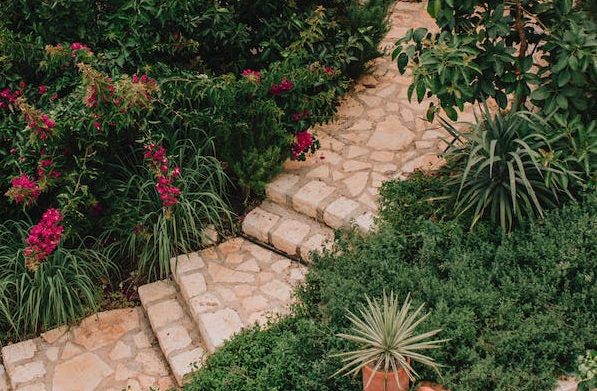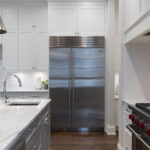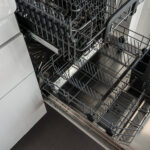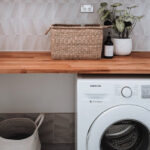Hardscaping Guide: Materials, Design Ideas & More

Photo credit: Ata Ebem
Designing a hardscape for your home’s outdoor space offers a wonderful opportunity to transform it into an inviting and functional haven. Hardscaping involves the use of non-living elements, such as patios, walkways, retaining walls, and water features, to enhance the aesthetics and usability of your landscape. As you embark on this exciting project, consider the following key factors to ensure a well-designed, harmonious, and enduring hardscape that perfectly complements your home.
Considerations When Designing a Hardscape
Purpose and Functionality
Before diving into the design process, define the purpose and functionality of your hardscape. Consider how you intend to use the space – whether it’s for outdoor dining and entertaining, relaxation, gardening, or a combination of activities. Understanding the primary function of the hardscape will guide your design decisions and layout choices.
Landscape Integration
Harmonizing the hardscape with the existing landscape is crucial for achieving a cohesive and visually appealing outdoor space. The design should seamlessly blend with the natural elements, such as trees, gardens, and topography, rather than overpowering them. A well-integrated hardscape creates a balance between soft and hard elements, enhancing the overall beauty of your home’s exterior.
Material Selection
Choosing the right materials for your hardscape is essential for both aesthetics and durability. An array of materials, such as natural stone, concrete pavers, brick, wood, and gravel, are available, each offering unique characteristics. Consider factors such as color, texture, longevity, and maintenance requirements when selecting materials that align with your design vision and lifestyle.
Climate and Maintenance
Take your region’s climate into account during the hardscape design process. Materials should be able to withstand the local weather conditions, including temperature fluctuations, rainfall, and freeze-thaw cycles. Additionally, think about the level of maintenance you’re willing to commit to. Choose materials and features that suit your maintenance preferences and time availability.
Accessibility and Flow
Ensure your hardscape design promotes smooth accessibility and flow throughout the outdoor space. Thoughtfully plan pathways, walkways, and transitions between different functional areas. A well-designed hardscape encourages easy navigation and fosters a sense of connectivity between different elements of your landscape.
Safety and Grading
Safety should always be a priority when designing your hardscape. Ensure proper landscape drainage and grading to prevent water accumulation, which can lead to slips, falls, and potential damage. Use slip-resistant materials for surfaces that are frequently wet, such as pool decks or areas near water features. Install proper lighting for improved visibility during nighttime use.
Privacy and Screening
Integrate privacy elements into your hardscape design, especially if you have close neighbors or face a busy street. Consider installing fencing, screens, trellises, or strategically placed plantings to create a sense of seclusion and tranquility in your outdoor space.
Lighting and Ambiance
Thoughtful lighting can transform your hardscape into a magical and inviting setting. Incorporate a mix of functional and decorative lighting to enhance safety, highlight architectural features, and create a warm ambiance during evenings. Well-placed lighting can extend the usability of your outdoor space and create a cozy atmosphere for gatherings.
Budget
Set a realistic budget for your hardscape project. Hardscaping can range from simple and affordable to elaborate and costly. Be mindful of your financial constraints and explore cost-effective options without compromising quality and design.
Local Regulations
Check local building codes, zoning regulations, and homeowner association rules before starting your hardscape project. Some areas may have restrictions on hardscape features like fire pits, outdoor kitchens, or the height of retaining walls.
Sustainability
Incorporate sustainable practices into your hardscape design. Choose permeable materials to allow water to seep into the ground, reducing runoff and the strain on local drainage systems. Utilize reclaimed materials or those sourced locally to minimize environmental impact.
Future Expansion
Plan for potential future expansions or additions to your hardscape. Consider leaving space for additional features or enhancements as your needs and preferences evolve over time.
Common Types of Materials for Hardscapes
Natural Stone
Benefits: Natural stone is a timeless and visually appealing choice for hardscaping, providing a unique and organic look to your outdoor space. Its durability ensures that it can last for decades with proper care.
Potential drawbacks: Natural stone is generally more expensive than other materials, and some varieties may require sealing to prevent staining.
Maintenance considerations: Regular cleaning and occasional resealing, if necessary, are essential to maintain its beauty and longevity.
Concrete Pavers
Benefits: Concrete pavers are a versatile option available in various shapes, colors, and patterns, offering great design flexibility. They are affordable and relatively easy to install.
Potential drawbacks: Over time, concrete pavers may fade or shift due to environmental factors and foot traffic.
Maintenance considerations: Periodic re-leveling and cleaning are necessary to keep them looking their best.
Brick
Benefits: Brick hardscaping creates a classic and charming aesthetic, imparting a warm and inviting feel to your outdoor space. Bricks are sturdy and long-lasting.
Potential drawbacks: They have limited color options and may be prone to moss or algae growth in shaded areas.
Maintenance considerations: Regular cleaning and resealing are important to prevent weathering and maintain their appearance.
Wood
Benefits: Wood is a natural choice that creates a rustic and warm ambiance in your hardscape design. It is ideal for decks, pergolas, and other outdoor structures.
Potential drawbacks: Wood is susceptible to rot, insect damage, and weathering.
Maintenance considerations: Regular staining, sealing, and inspection for damage are necessary to prolong its lifespan and keep it looking its best.
Gravel
Benefits: Gravel is a low-cost option for pathways and driveways, providing good drainage and preventing erosion.
Potential drawbacks: It can shift or scatter with heavy use or rainfall, making it less suitable for high-traffic areas.
Maintenance considerations: Occasional re-leveling and replenishing are required to maintain a uniform surface.
Composite Materials
Benefits: Composite materials are resistant to rot, insects, and weather conditions, offering the advantage of low maintenance. They come in various colors and textures, resembling natural wood or stone.
Potential drawbacks: They are generally more expensive than wood and may have a slightly artificial appearance.
Maintenance considerations: Minimal maintenance required; occasional cleaning may be sufficient.
Metal
Benefits: Metal hardscaping elements provide a modern and sleek touch to your landscape, adding an industrial feel. They are durable and weather-resistant.
Potential drawbacks: Metal can become hot in direct sunlight and may be prone to rust if not treated or coated.
Maintenance considerations: Regular cleaning and rust prevention measures are necessary to keep them in good condition.
Tile
Benefits: Tile offers a wide range of colors, patterns, and sizes, making it ideal for decorative accents and outdoor living spaces.
Potential drawbacks: Some tile materials may be prone to chipping or cracking in freezing temperatures.
Maintenance considerations: Regular cleaning and resealing are important for added protection and to preserve their beauty.
Choosing the right hardscape material involves weighing the specific needs, preferences, and budget for your outdoor space. Considering the maintenance requirements and potential pros and cons of each material will help you make informed decisions and ensure a successful hardscape design that enhances your outdoor living experience.
View other home construction and landscaping guides from Dwell Adore, and remember to collaborate with experienced landscape designers to bring your vision to life.
Home Gadgets & Appliances
- Choosing a Refrigerator: Door Layouts & Sizes

- Dishwasher Types: Benefits, Drawbacks & Considerations

- Washing Machine Guide: Which Is Best for You?

- Ultimate Guide to Blenders

Health & Wellness
- Resistant Starch Benefits, Foods & Types

- Types of Meditation: Finding Inner Peace & Clarity

- Quotes About Change & Life Transitions

- How to Stop Drinking Soda When You’re Addicted





